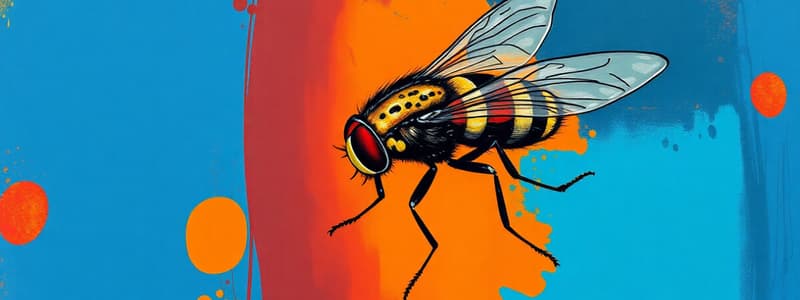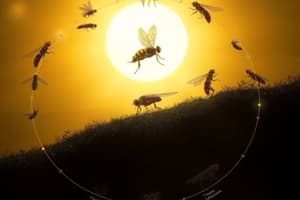Podcast
Questions and Answers
What is a significant disadvantage of traditional warble fly treatment methods?
What is a significant disadvantage of traditional warble fly treatment methods?
- They kill larvae too early during migration.
- They are only effective in winter.
- They do not affect the adult flies.
- They require multiple treatments during the warble season. (correct)
Which method is the most acceptable for administering systemic insecticides?
Which method is the most acceptable for administering systemic insecticides?
- Oral administration
- Dermal application using a 'pour-on' formulation (correct)
- Parenteral injection
- Spraying with a mist applicator
What is the primary action of organophosphorus insecticides against warble fly larvae?
What is the primary action of organophosphorus insecticides against warble fly larvae?
- Controlling larvae in the early stages of migration (correct)
- Repelling adult flies from laying eggs
- Activating the pupae before they emerge
- Killing larvae as they migrate through the host's body
During which months can insecticides not be effectively used for controlling larvae in the oesophagus or spinal canal?
During which months can insecticides not be effectively used for controlling larvae in the oesophagus or spinal canal?
What percentage control of infection can be achieved using the available organophosphate compounds?
What percentage control of infection can be achieved using the available organophosphate compounds?
What is the primary method used for controlling Tsetse flies?
What is the primary method used for controlling Tsetse flies?
Which insecticide has shown effectiveness in eradicating Glossina species when applied as wettable powder?
Which insecticide has shown effectiveness in eradicating Glossina species when applied as wettable powder?
What is a key factor limiting aerial insecticide application for Tsetse fly control?
What is a key factor limiting aerial insecticide application for Tsetse fly control?
Which of the following techniques allows selective application of insecticides for G.tachinoides?
Which of the following techniques allows selective application of insecticides for G.tachinoides?
What is the main concern with wholesale clearing of bushes in Tsetse fly management?
What is the main concern with wholesale clearing of bushes in Tsetse fly management?
In the context of aerial spraying for Tsetse control, which formulation is most extensively used?
In the context of aerial spraying for Tsetse control, which formulation is most extensively used?
What notable achievement was made by Nigerian authorities in Tsetse fly management?
What notable achievement was made by Nigerian authorities in Tsetse fly management?
The genus Gasterophilus is now classified under which family?
The genus Gasterophilus is now classified under which family?
What does G.palpalis prefer as its primary source of blood?
What does G.palpalis prefer as its primary source of blood?
What is the primary reason G.morsitans cannot exist permanently where big game is absent?
What is the primary reason G.morsitans cannot exist permanently where big game is absent?
Which control method for tsetse flies is currently emphasized in modern practices?
Which control method for tsetse flies is currently emphasized in modern practices?
During which season does G.palpalis typically ascend to the upper limits of rivers?
During which season does G.palpalis typically ascend to the upper limits of rivers?
What is one of the main reasons for the effectiveness of bush-clearing in controlling flies like G.palpalis?
What is one of the main reasons for the effectiveness of bush-clearing in controlling flies like G.palpalis?
What is indicated about the habitat preferences of Glossina species?
What is indicated about the habitat preferences of Glossina species?
Which method is mentioned as impractical for large areas while tracking fly density?
Which method is mentioned as impractical for large areas while tracking fly density?
What factor plays a crucial role in the prevalence of tsetse flies?
What factor plays a crucial role in the prevalence of tsetse flies?
Flashcards are hidden until you start studying
Study Notes
Tsetse Fly Control
- Insecticides are the primary method for controlling tsetse flies.
- Persistent insecticides like DDT and dieldrin applied from the ground have been successful in eradicating tsetse flies in areas like Sudan and Nigeria.
- Discriminative application of insecticides is effective, targeting specific areas like riverine vegetation where flies congregate.
- Aerial spraying using helicopters, especially during dry seasons and specific temperature conditions, has yielded positive results in controlling tsetse fly populations.
- Non-persistent insecticides sprayed from the air at regular intervals, coinciding with the pupal stage of the flies, are another effective method.
- Endosulfan and isobenzan are examples of non-persistent insecticides used for tsetse fly control.
Warble Fly Control
- Organophosphorus systemic insecticides are effective in controlling warble fly larvae before they cause significant damage to cattle.
- These insecticides are applied once during the autumn or winter before larvae appear on cattle.
- Oral, parenteral, and dermal application methods are available, with pour-on formulations being the most common.
- Crufofnate, famphur, fenthion, and phospmet are examples of organophosphate compounds used for warble fly control.
- Systemic insecticides are highly effective in controlling warble fly infections, reducing infestations by 90% or more
Tsetse Fly Ecology
- Primary fly centers are areas where flies congregate during unfavorable seasons due to factors like vegetation and water availability.
- Flies migrate outwards from primary fly centers to temporary haunts during favorable seasons.
- Host preference is a key factor in tsetse fly distribution, with some species preferring specific hosts like humans or large mammals.
- G. palpalis thrives best on the blood of warm-blooded animals, including humans and crocodiles, but is not dependent on big game for its existence.
- G. morsitans feeds on various large mammals and birds but requires the presence of big game or cattle for long-term survival.
Other Tsetse Fly Control Methods
- Bush-clearing is an important method of control, particularly for flies like G. palpalis that require shade.
- Clearing vegetation around settlements, wells, landing places, and roads helps reduce fly populations and protect humans.
- Hand netting is only effective for smaller areas and is primarily used for population density monitoring.
- Trapping methods, based on the fly's attraction to shadows, are widely used for capturing tsetse flies.
- Slaughter of game and bush-clearing were older methods of control but are rarely used today.
Studying That Suits You
Use AI to generate personalized quizzes and flashcards to suit your learning preferences.




